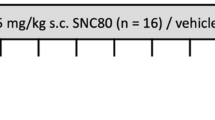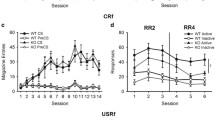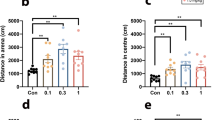Abstract
Rationale
Relatively little is known about the neural mechanisms underlying anxiety in the novelty-induced hypophagia test, the only known anxiety test that is responsive to chronic but not acute or subchronic antidepressant treatment.
Objectives
The goal of the present experiment was to characterize the role of serotonin in the ability of novelty to suppress feeding.
Materials and methods
Pair-housed male Sprague–Dawley rats were trained to eat graham cracker crumbs individually in their home cage (15 min/day). After stable daily intakes were obtained, the animals were depleted of serotonin using 4-chloro-dl-phenylalanine (150 mg kg−1 day−1 × 2 days). Forty-eight hours later, central serotonin was restored by the administration of the peripheral l-aromatic amino acid decarboxylase inhibitor, benserazide (10 mg/kg), followed 15 min later with the immediate precursor of serotonin, 5-hydroxy-l-tryptophan (30 mg/kg). Thirty minutes later, the animals were given access to graham cracker crumbs in a novel environment.
Results
The animals demonstrated increased latencies to approach the food and reduced food intake in the novel environment. This effect was attenuated by serotonin depletion. Repletion of central serotonin restored the inhibitory response to novelty. The analysis of serotonin content in different brain regions confirmed that serotonin was depleted by greater than 90%, whereas the repletion treatment resulted in serotonin levels similar to nondepleted animals.
Conclusions
Acute depletion of serotonin acts to reduce anxiety behavior as measured by an inhibitory anxiety response during exposure to novel stimuli. These findings are in agreement with the proposed general role for serotonin in behavioral inhibition and that reductions of serotonin facilitate the adoption of more active coping responses to stress.



Similar content being viewed by others
References
Artaiz I, Zazpe A, Del Rio J (1998) Characterization of serotonergic mechanisms involved in the behavioural inhibition induced by 5-hydroxytryptophan in a modified light–dark test in mice. Behav Pharmacol 9:103–112
Bodnoff SR, Suranyi-Cadotte B, Aitken DH, Quirion R, Meaney MJ (1988) The effects of chronic antidepressant treatment in an animal model of anxiety. Psychopharmacology 95:298–302
Bodnoff SR, Suranyi-Cadotte BE, Quirion R, Meaney MJ (1989) Role of the central benzodiazepine receptor system in behavioral habituation to novelty. Behav Neurosci 103r:209–212
Borbely AA, Huston JP, Waser PG (1973) Physiological and behavioral effects of parachlorophenylalanine in the rat. Psychopharmacologia 31:131–142
Borsini F, Podhorna J, Marazziti D (2002) Do animal models of anxiety predict anxiolytic-like effects of antidepressants? Psychopharmacology 163:121–141
Chaouloff F (2000) Serotonin, stress and corticoids. J Psychopharmacol 14:139–151
Czlonkowska AI, Zienowicz M, Bidzinski A, Maciejak P, Lehner M, Taracha E, Wislowska A, Plaznik A (2003) The role of neurosteroids in the anxiolytic, antidepressive and anticonvulsive effects of selective serotonin reuptake inhibitors. Med Sci Monit 9:RA270–RA275
Dulawa SC, Hen R (2005) Recent advances in animal models of chronic antidepressant effects: the novelty-induced hypophagia test. Neurosci Biobehav Rev 29:771–783
Dulawa SC, Holick KA, Gundersen B, Hen R (2004) Effects of chronic fluoxetine in animal models of anxiety and depression. Neuropsychopharmacology 29:1321–1330
Duman RS (2004) Depression: a case of neuronal life and death? Biol Psychiatry 56:140–145
Fernandez-Guasti A, Lopez-Rubalcava C (1990) Evidence for the involvement of the 5-HT1A receptor in the anxiolytic action of indorenate and ipsapirone. Psychopharmacology 101:354–358
File SE, Hyde JR (1977) The effects of p-chlorophenylalanine and ethanolamine-O-sulphate in an animal test of anxiety. J Pharm Pharmacol 29:735–738
Gammans RE, Stringfellow JC, Hvizdos AJ, Seidehamel RJ, Cohn JB, Wilcox CS, Fabre LF, Pecknold JC, Smith WT, Rickels K (1992) Use of buspirone in patients with generalized anxiety disorder and coexisting depressive symptoms. A meta-analysis of eight randomized, controlled studies. Neuropsychobiology 25:193–201
Germine M, Goddard AW, Sholomskas DE, Woods SW, Charney DS, Heninger GR (1994) Response to meta-chlorophenylpiperazine in panic disorder patients and healthy subjects: influence of reduction in intravenous dosage. Psychiatry Res 54:115–133
Halford JC, Harrold JA, Lawton CL, Blundell JE (2005) Serotonin (5-HT) drugs: effects on appetite expression and use for the treatment of obesity. Current Drug Targets 6:201–213
Harvey JA, Schlosberg AJ, Yunger LM (1975) Behavioral correlates of serotonin depletion. Fed Proc 34:1796–1801
Higgins GA, Jones BJ, Oakley NR (1992) Effect of 5-HT1A receptor agonists in two models of anxiety after dorsal raphe injection. Psychopharmacology (Berlin) 106:261–267
Hollander E, DeCaria C, Gully R, Nitescu A, Suckow RF, Gorman JM, Klein DF, Liebowitz MR (1991) Effects of chronic fluoxetine treatment on behavioral and neuroendocrine responses to meta-chlorophenylpiperazine in obsessive–compulsive disorder. Psychiatry Res 36:1–17
Kennett GA, Lightowler S, de Biasi V, Stevens NC, Wood MD, Tulloch IF, Blackburn TP (1994) Effect of chronic administration of selective 5-hydroxytryptamine and noradrenaline uptake inhibitors on a putative index of 5-HT2C/2B receptor function. Neuropharmacology 33:1581–1588
Kirby LG, Chou-Green JM, Davis K, Lucki I (1997) The effects of different stressors on extracellular 5-hydroxytryptamine and 5-hydroxyindoleacetic acid. Brain Res 760:218–230
Koprowska M, Krotewicz M, Romaniuk A, Strzelczuk M, Wieczorek M (1999) Behavioral and neurochemical alterations evoked by p-chlorophenylalanine application in rats examined in the light–dark crossing test. Acta Neurobiol Exp (Wars) 59:15–22
Kshama D, Hrishikeshavan HJ, Shanbhogue R, Munonyedi US (1990) Modulation of baseline behavior in rats by putative serotonergic agents in three ethoexperimental paradigms. Behav Neural Biol 54:234–253
Lucki I (1996) Serotonin receptor specificity in anxiety disorders. J Clin Psychiatry 57(Suppl 6):5–10
Marsden CA, Curzon G (1976) Studies on the behavioural effects of tryptophan and rho-chlorophenylalanine. Neuropharmacology 15:165–171
Marsden CA, Curzon G (1977) Effects of p-chlorophenylalanine and alpha-methyltryptophan on behaviour and brain 5-hydroxyindoles. Neuropharmacology 16:489–494
Mayorga AJ, Dalvi A, Page ME, Zimov-Levinson S, Hen R, Lucki I (2001) Antidepressant-like behavioral effects in 5-HT1A and 5-HT1B receptor mutant mice. J Pharmacol Exp Ther 298:1101–1107
Merali Z, Levac C, Anisman H (2003) Validation of a simple, ethologically relevant paradigm for assessing anxiety in mice. Biol Psychiatry 54:552–565
Merali Z, Khan S, Michaud DS, Shippy SA, Anisman H (2004) Does amygdaloid corticotropin-releasing hormone (CRH) mediate anxiety-like behaviors? Dissociation of anxiogenic effects and CRH release. Eur J Neurosci 20:229–239
Minabe Y, Emori K, Ashby CR Jr (1996) The depletion of brain serotonin levels by para-chlorophenylalanine administration significantly alters the activity of midbrain dopamine cells in rats: an extracellular single cell recording study. Synapse 22:46–53
National Research Council (1996) Guide for the care and use of laboratory animals. National Academy Press, Washington, DC
Nutt DJ (2001) Neurobiological mechanisms in generalized anxiety disorder. J Clin Psychiatry 62(Suppl 11):22–27 (discussion 28)
Oshima T, Kasuya Y, Terazawa E, Nagase K, Saitoh Y, Dohi S (2001) The anxiolytic effects of the 5-hydroxytryptamine-1A agonist tandospirone before otolaryngologic surgery. Anesth Analg 93:1214–1216
Quested DJ, Sargent PA, Cowen PJ (1997) SSRI treatment decreases prolactin and hyperthermic responses to mCPP. Psychopharmacology (Berlin) 133:305–308
Rex A, Marsden CA, Fink H (1993) Effect of diazepam on cortical 5-HT release and behaviour in the guinea-pig on exposure to the elevated plus maze. Psychopharmacology (Berlin) 110:490–496
Santarelli L, Saxe M, Gross C, Surget A, Battaglia F, Dulawa S, Weisstaub N, Lee J, Duman R, Arancio O, Belzung C, Hen R (2003) Requirement of hippocampal neurogenesis for the behavioral effects of antidepressants. Science 301:805–809
Soderpalm B, Engel JA (1989) Does the PCPA induced anticonflict effect involve activation of the GABAA/benzodiazepine chloride ionophore receptor complex? J Neural Transm 76:145–153
Stein L, Wise CD, Belluzzi JD (1975) Effects of benzodiazepines on central serotonergic mechanisms. Adv Biochem Psychopharmacol 14:29–44
Treit D, Robinson A, Rotzinger S, Pesold C (1993) Anxiolytic effects of serotonergic interventions in the shock-probe burying test and the elevated plus-maze test. Behav Brain Res 54:23–34
Tye NC, Iversen SD, Green AR (1979) The effects of benzodiazepines and serotonergic manipulations on punished responding. Neuropharmacology 18:689–695
Vaswani M, Linda FK, Ramesh S (2003) Role of selective serotonin reuptake inhibitors in psychiatric disorders: a comprehensive review. Prog Neuro-psychopharmacol Biol Psychiatry 27:85–102
Weissman A, Koe BK (1965) Behavioral effects of l-alpha-methyltyrosine, an inhibitor of tyrosine hydroxylase. Life Sci 4:1037–1048
Yoshioka M, Matsumoto M, Togashi H, Saito H (1995) Effects of conditioned fear stress on 5-HT release in the rat prefrontal cortex. Pharmacol Biochem Behav 51:515–519
Acknowledgment
This study is supported by MH14654, MH72832, and by the National Alliance for Research on Schizophrenia and Depression.
Author information
Authors and Affiliations
Corresponding author
Rights and permissions
About this article
Cite this article
Bechtholt, A.J., Hill, T.E. & Lucki, I. Anxiolytic effect of serotonin depletion in the novelty-induced hypophagia test. Psychopharmacology 190, 531–540 (2007). https://doi.org/10.1007/s00213-006-0615-9
Received:
Accepted:
Published:
Issue Date:
DOI: https://doi.org/10.1007/s00213-006-0615-9




